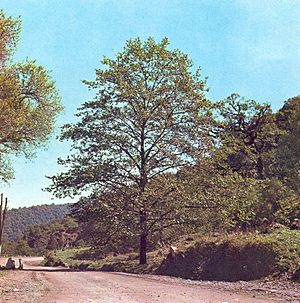Alnus acuminata facts for kids
Quick facts for kids Alnus acuminata |
|
|---|---|
 |
|
| Conservation status | |
| Scientific classification | |
| Synonyms | |
|
The Andean alder, also known as Alnus acuminata, is a type of deciduous tree. This means it's a tree that loses its leaves every year. It belongs to the Betulaceae family, which includes birches and hazels. You can find this tree growing in mountain forests from central Mexico all the way down to Argentina.
Contents
What Does the Andean Alder Look Like?
The Andean alder can grow very tall, up to 25 meters (about 82 feet). Its trunk can be quite thick, reaching up to 150 centimeters (about 59 inches) across. The bark has many yellowish spots called lenticels, which are like small pores that help the tree breathe.
Its leaves are simple and oval-shaped, with edges that look like tiny teeth. The tree has special flowers called catkins. These are long, thin clusters of flowers. The male and female flowers grow separately on the same tree.
- The male flowers are long, up to 12 centimeters (about 5 inches), and hang down.
- The female flowers are smaller, green, and stand upright. They look a bit like tiny pinecones.
After the wind carries pollen from the male to the female flowers (this is called wind fertilization), the female flowers grow into fruits. These fruits are woody, brown, and about 2 centimeters (about 0.8 inches) long. When they are ripe, they open up to release their seeds. Each fruit can hold 80 to 100 seeds, and each seed has a small "wing" that helps it fly away in the wind. The empty fruit husks stay on the tree.
There are three main types (subspecies) of Alnus acuminata:
- Alnus acuminata subsp. acuminata grows from Colombia and Venezuela down to northern Argentina.
- Alnus acuminata subsp. arguta is found from northwestern Mexico down to Panama.
- Alnus acuminata subsp. glabrata lives in central and southern Mexico.
Where Does the Andean Alder Grow?
The Andean alder lives in the mountains of Central and South America. It grows at high altitudes, usually between 1,500 and 3,200 meters (about 4,900 to 10,500 feet) above sea level. It prefers areas that get a good amount of rain, typically 1,000–3,000 millimeters (about 39–118 inches) per year. You'll often find it on slopes and in valleys.
This tree is quite tough! It can grow in poor or acidic soils, but it likes silt or sandy silt soils best. It's known as a "pioneer species," which means it's one of the first trees to grow in an area that has been disturbed, like after a landslide. It grows quickly and is helpful for protecting watersheds (areas of land that drain into a river or lake). It also helps improve the soil because its roots have special bumps called root nodules. These nodules contain tiny living things that can "fix nitrogen," which means they turn nitrogen from the air into a form that plants can use as food.
What Is Andean Alder Wood Used For?
The wood from the Andean alder is light to reddish-brown and has a fine grain. It's a useful type of wood! People use it for:
- Building bridges and pilings (strong posts driven into the ground).
- Making coffins, boxes, and crates.
- Creating furniture.
- Producing plywood (a type of wood made from thin layers glued together).
It's also good for firewood because it burns steadily and gives off good heat.
See also
 In Spanish: Aliso para niños
In Spanish: Aliso para niños



